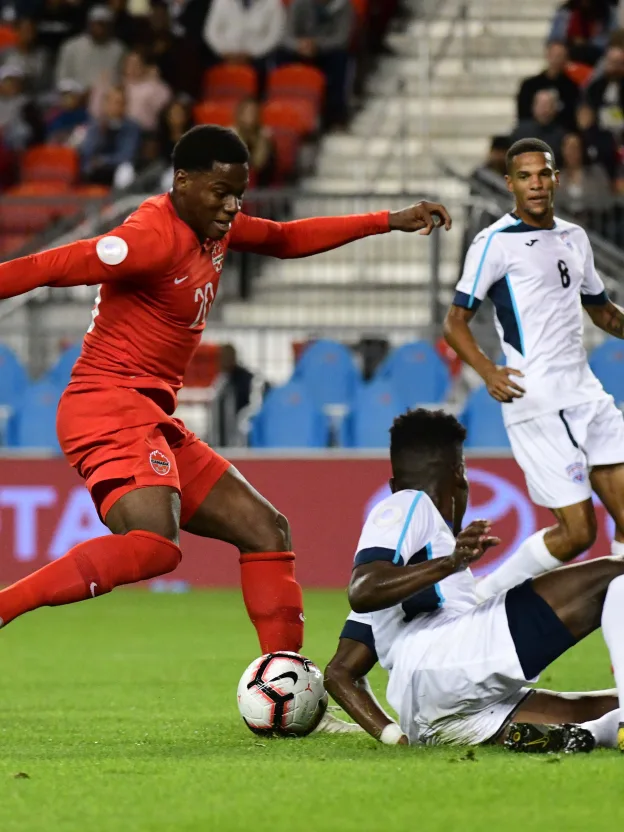“What a football story that could be and something that country could rally around if Canada was to go through 12 matches to take that chance at playing in the half spot. That’s what Concacaf have offered to those teams that might not be able to accumulate the ranking points in the time that they’ve got left.” — John Herdman, soon after Concacaf announced the World Cup 2022 qualifying format. The story was waiting to be told. Two late-March friendlies in name only — in truth, two do-or-die games against Trinidad and Tobago, in front of packed houses on Vancouver Island. The Canadian men’s team embarking on a desperate last-ditch push to overtake El Salvador in the FIFA world rankings. Get that sixth spot, and Canada goes to the Hex, where the top three make it to Qatar 2022. There would be high-profile home and away matches against the United States and Mexico. But, the two “friendlies” were casualties of the ever-growing worldwide suspension of sporting events and leagues, as the human race tries to band together by keeping people apart. To try and slow the global COVD-19 pandemic, the playing fields will be empty for the foreseeable future. Even the Canadian Premier League is affected, in the midst of a two-week hold on training camps. With several Canadian provinces recommending the cancellation of events of over 250 people, those restrictions would need to be lifted before any league in Canada can think about resuming.
RELATED READING: CPL pre-season roster tracker: How each team is shaping up
Those two T&T cancellations have huge implications for coach John Herdman and the Canadian men’s team, though. Remember that, right after he was hired to take over the men’s program, Herdman boldly predicted that Canada would be at the 2022 World Cup. He spoke about it repeatedly as a matter of when Canada qualifies, not if. But, Canada still trails El Salvador 1346-1332 on the FIFA coefficient points table. Canada needed to pile up positive results up to the deadline for Hex qualification, set at the conclusion of the June international window. So, it looks as if Canada’s quest for the Hex won’t end on a field. It won’t end with a valiant last-ditch push to get into Concacaf’s top six by FIFA ranking points. It won’t end with a bitter one-goal loss or another embarrassing 8-1 rout. It will end with a string of postponements. Countries ranked seventh to 35th in Concacaf go into a war of attrition, a long tournament to determine one survivor. That survivor will play the fourth-place team in the Hex for the chance to play yet another play-in series to get to Qatar. It is a lonnnnnggggg road. Being forced into the 7-35 kumite gets you games with island nations named for saints. The soccer world is in limbo right now. I asked Concacaf if any consideration has been given to moving the June deadline. I haven’t received a response. I’d usually be annoyed at not getting the answers, but I understand that, as the COVID-19 situation changes, we’re all having problems seeing exactly what the future holds. But, based on the assumption that the world will get back to normal by that time, the 7-35 tournament is set to begin in September. Groups need to be drawn. Matches need to be scheduled. Unless that September window moves, it’s hard to see an extension being made to the June deadline. So, we may revel in the fact that Jonathan David may set the all-time Canadian scoring record in short order, with so many games coming up against minnow nations. But, the truth is, Canada will have a hard road.

Panama and Haiti, not lightweights, are also set to be in the second-chance tournament. Without games against Mexico or the U.S., there will be less mainstream interest in Canadian soccer. And, when the likes of Saint Lucia or Puerto Rico are on the schedule, will there be hesitation from the European clubs to send some of their Canadian players over? Will we see players pick up “knocks” and “tight hamstrings” right when Herdman makes his roster announcements? A lot has been said about the new qualifying format Concacaf unveiled. A lot has been said about the fact that national associations were led to believe that, when the format changes was first discussed, Concacaf’s internal rankings were going to be used rather than the FIFA rankings. (Canada would have been fine under that system, as games against the non-countries such as Guadeloupe and Bonaire count in Concacaf rankings; FIFA ignores them.) I’ve seen some of my followers on Twitter comment that Concacaf should force some sort of playoff between Canada and El Salvador for the final Hex spot. Easy to shout for that when your team is on the outside looking in. Truth is, had Canada not surrendered a two-goal lead to Haiti in the most recent Gold Cup, and then earned the right to play at least one more game at the tournament, it would have racked up points it badly needed. Canada lost to Iceland in January. And, through the last few years, we’ve seen more than a few match-less international windows for Canada. Put it this way, if Canada had been in sixth and El Salvador in seventh, what would be the appetite for a “playoff?” None whatsoever, at least in this country. The fact is, Canada was in a hole that was dug over the course of a few years, and it all came down to a last-second charge to get to the surface. World events have dictated otherwise. You can either blame COVID-19, or blame the program that dug the hole. 
